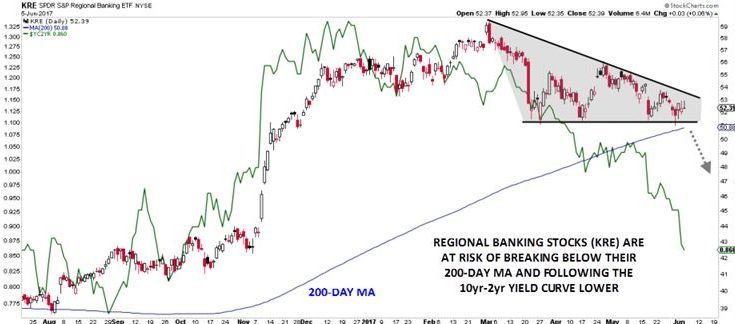Last week, we wrote about how the improving performance of the US utility sector suggested that the Federal Reserve was less likely to raise interest rates aggressively over the rest of the year. We highlighted that, “if we see a lukewarm NFP report on Friday, it would raise the chances of another “dovish hike,” where the FOMC raises interest rates but strives to downplay expectations for future interest rate hikes this year. That scenario could result in continued strength in higher-yield utility and REIT stocks, as well as underperformance in regional banks and the US dollar” (see “Sector showcase: The utility of utilities for handicapping the Fed” for more).
As our readers should know by now, Friday’s jobs report was indeed tepid, showing that only 138k new jobs were created in May, well below expectations of an 180k gain.  Today we wanted to check in with another intermarket relationship, the performance of regional banking stocks, to see if it confirms the “lower for longer” case for US interest rates.
While most megabanks make the majority of their profits through investment banking and trading activities, regional banks tend to be more straightforward. Regional banks “bread and butter” business is borrowing and lending money, and their profits, therefore, tend to fluctuate with the “net interest margin” or the difference between short-term interest rates used for borrowing money (i.e. through savings and checking accounts) and longer-term interest rates used for lending money (i.e. on business, car, and home loans).
The chart below shows the recent performance of regional banking stocks (KRE) and the 10yr-2yr yield spread, a proxy for the “net interest margin”:

Source: Stockcharts.com
As you can see, the 10yr-2yr yield spread (green) has more than reversed all of its gains since the US election, while regional banks have held up better. This divergence is unlikely to hold for long: in our view, either the yield curve will start steepening again, or regional banking stocks will drop sharply to “catch down” with the recent drop in interest rates.

